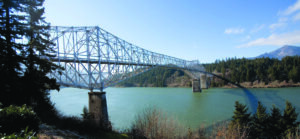

Quite a few years ago, I was invited to make some presentations at a business conference being held at the Skamania Lodge in Stevenson, Washington. Since I had never been to Skamania, and was still relatively new to Oregon/Washington, I asked for directions on how best to get there.
“Easy!” said the meeting coordinator. “Just take I-84 east until you come to the Bridge of the Gods. Take that toll bridge across to the Washington side. You’ll be practically there!”
She was right: it was a quick and easy trip through that part of the gorge, past waterfalls on both sides of the Columbia River—beautiful!
Later, I was doing a bit of research for the Fairview-Rockwood-Wilkes Historical Society about another matter and I stumbled across a website that featured “An Illustrated History of Klickitat, Yakima, & Kittitas Counties” which had been originally printed in 1904 by the Interstate Publishing Co., Chicago, Illinois. The particular article which caused me to “stumble” was “Part III, History of Klickitat County: 1889-1904.”
Included in the many historical references to various events of interest during that era, was the completion of the construction of the Cascade Locks on the Columbia (1896) which had been greatly anticipated by the residents and merchants of the upper Columbia. The cascade rapids at that part of the Columbia had forced travelers and cargoes to portage around that treacherous spot. The locks significantly reduced the cost and added immeasurably to the convenience and safety associated with transportation up and down the river.
Reading a bit further, the article contained some interesting anecdotes about the legends about how the cascades were originally formed. Many local Indian Tribes relate similar stories carried down through their oral traditions, about this great obstruction to navigation. They state that at one time a mighty natural bridge spanned the river at this point, over which the Indian people were able to cross, and under which they could canoe with ease.
One legend says that “the great mountains made war on each other, first manifesting their anger and making declaration of war by puffing forth smoke: after which they growled and spit fire and hurled rocks at one another, deluging the surrounding country with showers of ashes. Finally, they shook the whole earth and the bridge fell, damming up the river with huge masses of rocks and forming the cascades.”
According to F.H. Balch in his book, The Bridge of the Gods, “Everywhere along the mid-Columbia the Indians tell of a great bridge that once spanned the river where the cascades now are, but where at that time the placid current flowed under an arch of stone; that this bridge was tamanowos, built by the gods; that the great spirit shook the earth, and the bridge crashed down into the river, forming the present obstruction of the cascades. All the Columbia tribes tell this story in different versions and in different dialects, but all agreeing upon its essential features as one of the great facts of their past history.”
Balch cites a story told by an old Klickitat to a pioneer at White Salmon, Washington: “My father talk one time, long time ago, him in canoe, his mother paddle, paddle up Columbia, then come tamanowos bridge…all dark under bridge. He look up all like one big roof, shut out sky, no see sun. Indian afraid, paddle quick, get past quick, no good. Boy no forget how bridge looked.”
Balch went on to say that these legends were born out by local current evidence, especially during the fall when the freshets were over and the waters of the Columbia were clear. He said that it was possible to go out in a small boat, just above the cascades, and actually see the submerged forest trees beneath, “still standing upright as they stood before the bridge fell in and the river was raised above them. It is a strange, weird sight, this forest beneath the river…where fish swim among the leafless branches…desolate, spectre-like.”
The author stated that scientific men who had examined the field with the objective of determining the credibility of the legend about the local bridge “that it is essentially true. Believed in by many tribes, attested by the appearance of the locality, and confirmed by geological investigation, it is surely entitled to be received as a historic fact.”
This all sounded so interesting and I just loved reading it. I wanted to learn more—so, I started surfing the Web for more references to the “Bridge of the Gods.” I found several web sites, many quoting similar legends and opinions regarding the “original” natural bridge, but also citing differing opinions regarding the “geological proof.”
At least two other web sites related a legend that goes something like this: “Long ago, when the world was young, there were two brothers competing over the land. One day the Great Spirit took them to a new country and put them on top of a high mountain. There were mountains all around, with a river flowing between them. ‘Each of you shoot an arrow.’ The Great Spirit said, ‘one to the North and one to the South. Then you will follow your arrow. Where it falls will be your country. There you will become great chiefs. The river will separate your lands.’ One brother shot his arrow south into the Willamette valley. He became the father and chief of the Multnomah people. The other broth shot his arrow north into the Klickitat country. He became the father and chief of the Klickitat people. The Great Spirit built a bridge over the big river to be a sign of peace between them. This was a bridge of rocks. ‘As long as you and your people are friendly with each other, this bridge will stand,’ he told the chiefs. When the two tribes began to fight, the Great Spirit destroyed the bridge.” The rapids were the remnants of the collapsed bridge.
Regarding the geological authenticity of these legends, the OPB’s Oregon Field Guide Web Site entitled “Bridge of the Gods—Geologic History,” says: “When early settlers arrived in Oregon, they heard the legends and many misinterpreted the descriptions as an actual bridge arching over the Columbia. However, geologists believe this to be very unlikely because the material from the landslide was primarily unstable rock and gravel.”
OPB cites opinions of current geologists who say that there was, about 500 years ago, a giant landslide from the northern shore of the Columbia River that blocked the Gorge, and actually stopped the waters of the Columbia River. The natural dam formed by the slide resulted in a lake over 80 miles long, 50 to 100 feet deep, and up to 1 mile wide, filling the Gorge to the east and flooding forests along the river. Eventually the pressure built up against the dam caused the rock and gravel to give way. Waves up to 50 feet tall rushed down the Gorge, flooding what is now the greater Portland area, and washing away evidence of thousands of years of human occupation. After the dam was breached, the river flowed again over remnants too large to be washed away—thus forming the Cascade Rapids.
Today, a real bridge spans the same expanse of river, near the spot where, according to legend, the original natural bridge once stood. About four miles upriver from the Bonneville Dam, stands the beautiful cantilever bridge, which is 1,858 feet long. The new Bridge of the Gods was completed in 1926 by the Sauna Toll Bridge Company. This 3rd oldest bridge on the Columbia was privately owned until 1961 when it was purchased by the Port of Cascade Locks. Around 1940, after the completion of the construction of Bonneville Dam, the bridge was jacked up and its piers were extended. It now stands 135 feet above water.
There are no eyewitness accounts of the landslide that created the Cascade Locks. The only inhabitants along the Columbia River at the time were the Klickitats and other local tribal people, and their legends all carry a common thread about the tamanowos bridge—the natural arch that at one time spanned the great Columbia River.
Somehow, I prefer to believe there really was a natural bridge there, and that the Great Spirit brought it down when his people refused to live in peace. Which version do you prefer?
References:
www.homepages.rootsweb.com/~westklic/part2713
www.opb.org/programs/’bridge/legends
“Indian Legends,” Ella Clark, 1953
“The Bridge of the Gods,” F.H. Balch
Other resources:
No Comments
Leave a comment Cancel